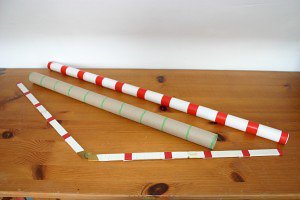As a new school year begins this is a reminder to use the trusty old counting stick! I know it’s been around a while – but for good reason. It is an excellent, flexible model for a number line, and a great way of managing interaction with the whole class.
If you haven’t got one it is easy to make your own counting stick. A broom handle with electrical tape as markers is good – or use a metre stick marked off in ten equal divisions. It can be used in early years maths lessons all the way up to Y6, which means it is possible to give a whole class activity to all abilities, making it very inclusive.
The key is not the stick itself but how you use it – so practice the technique:
range – count – repeat – jump – random – change
Count: point to each marker in turn and ask the class to say together the value. Pupils must match the finger position and not race ahead with the counting.
Repeat: start again from 0 and then at 500 instead of going on to 600, go back to 400. Go on again to 500, emphasizing the mid-point, and then keep repeating numbers backwards and forwards until you reach 1000.
Jump: start at zero and jump in twos. Start at 100 and jump in twos.
Random: point to random positions – do they know the numbers?
Change: ask ability groups to count in turn. For your group of low achievers say that you are going to give them a challenge and change the numbers to 0 and 100 – can they count up (and down) in tens. Turn to your high achievers and say that the numbers have changed again, this time to 0 and 100,000 – can they count in ten thousands? Point to the midway position between 0 and the next marker and ask the value.
You may have goldfish (just open and close their mouths…) and echoes (a few seconds behind everyone else…) in your class.
By listening and joining in when they can, they will learn. A small acknowledgment from you – a smile or a nod – to show that you spotted them joining in will work wonders for their self-esteem.
Year 1
Use a counting stick, marked off in ten equal divisions, and call one end of the stick zero and the other 20
Starting from zero, move a finger along the stick, a division at a time, and ask which number would go there.
Repeat but stopping partway through the count sequence and move your finger back one place before continuing. Stop and go back to different numbers.
Point to random positions on the stick and ask pupils for the number.
Year 2
Use a counting stick, marked off in ten equal divisions, and call one end of the stick zero and tell pupils they are going to count along the stick in twos.
Starting from zero, move a finger along the stick, a division at a time, and ask which number would go there.
Repeat, counting on in twos from zero, but this time stop partway through the count sequence and move your finger back a division before continuing. two four six (move finger back) four six eight, …
Repeat for counting back. twenty eighteen sixteen (move finger back) eighteen sixteen fourteen, …
Point to random positions on the stick and ask pupils for the appropriate number.
Repeat these activities for counting in ones, fives and tens.
Year 4
Use a counting stick, marked off in ten equal divisions, and call one end of the strip zero and the other 1000.
Point to these positions in turn and ask for the number 500, 200, 800…
Extend this by pointing to the positions of 650, 450, 750… Explain that these positions are approximations.
Name the ends of the strip zero and 10,000. Ask them to say the numbers at positions 5000, 3000, 7000…
Extend this by asking to be shown the positions of 1500, 4500, 3500, 8500, …
Year 5
Use a counting stick, marked off in ten equal divisions, and call one end of the stick zero and the other end 1.
Point to each division in turn and ask for the appropriate decimal number. Repeat pointing to random positions.
If pupils are confident with this activity point to the mid points between the divisions to generate decimal numbers such as 0.75, 0.25, 0.95, …
Year 6
Use a counting stick, marked off in ten equal divisions, and call one end of the stick 10 and the other -10. Hold the stick in the centre to show zero.
Point to each division in turn and ask for the appropriate number.
Point to positions randomly, including mid points, and ask for the appropriate numbers.
Repeat the activities with the ends of the stick as 0 to -20 and 0 to -100.



